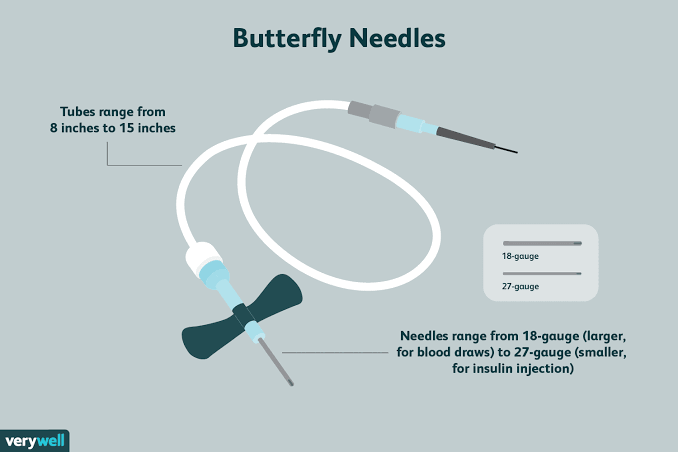Introduction
If you’ve ever had blood drawn or received an injection, chances are a butterfly needle was involved. Known for its small size and wing-like design, this needle has become a favorite among healthcare professionals and patients alike. But why is it called a butterfly needle? And what makes it so special?
In this blog post, we’ll explore everything you need to know about butterfly needles—from how they work to their benefits and uses. Whether you’re curious about medical procedures or just want to ease your fears about needles, this guide will make it all feel simple and approachable.
Table of Contents
- What Is a Butterfly Needle?
- How Does a Butterfly Needle Work?
- Common Uses of Butterfly Needles
- Advantages of Butterfly Needles
- Are There Any Downsides?
- Tips for Patients: How to Stay Calm During Procedures
- Frequently Asked Questions
- Conclusion
Contents
1. What Is a Butterfly Needle?
A butterfly needle is a small, thin needle with flexible wings on either side. These wings allow healthcare providers to hold and control the needle with precision. It’s attached to a flexible tube, which makes it ideal for delicate or hard-to-reach veins.
The name comes from the winged design, which resembles a butterfly. While it’s primarily used in medical settings, its user-friendly design makes it a preferred choice for drawing blood, administering medication, and even IV treatments.
2. How Does a Butterfly Needle Work?
The butterfly needle’s design helps it glide into veins smoothly. Here’s a quick breakdown of how it works:
- The healthcare provider pinches the wings for a steady grip.
- The needle is inserted into the vein at a shallow angle.
- Blood or medication flows through the flexible tubing connected to the needle.
Its thin, short structure reduces discomfort, especially for patients with smaller or fragile veins.
3. Common Uses of Butterfly Needles
Butterfly needles are versatile and can be used in various medical procedures:
- Blood Draws: Ideal for patients with small or hard-to-find veins.
- IV Medications: Often used to administer fluids or medications.
- Pediatric Care: Perfect for children due to its gentle insertion.
- Elderly Patients: Great for older adults with fragile veins.
Because they’re easy to maneuver, butterfly needles are especially helpful in situations where precision matters.
4. Advantages of Butterfly Needles
Why do healthcare professionals love butterfly needles? Here are the key benefits:
- Comfortable for Patients: The small size and shallow angle reduce pain and discomfort.
- Precision: The flexible wings give more control, making it easier to find and access veins.
- Versatility: Suitable for both blood draws and medication delivery.
- Less Risk of Vein Damage: Ideal for fragile veins or those prone to collapsing.
5. Are There Any Downsides?
While butterfly needles have many advantages, there are a few limitations:
- Limited Flow Rate: They’re not ideal for procedures requiring large amounts of fluid quickly.
- Slightly Higher Cost: Butterfly needles are more expensive than standard needles.
- Fragility: The smaller design means the needle can bend if not handled carefully.
Despite these drawbacks, their benefits often outweigh the downsides, especially for patients with specific needs.
6. Tips for Patients: How to Stay Calm During Procedures
Are you nervous about needles? You’re not alone! Here are some tips to make the experience less stressful:
- Take Deep Breaths: Breathing deeply can help relax your body and mind.
- Distract Yourself: Bring headphones or a stress ball to keep your focus elsewhere.
- Communicate: Let your healthcare provider know if you’re anxious—they’ll take extra care.
- Look Away: Watching the needle can make things worse, so turn your head away.
- Trust the Process: Remember, butterfly needles are designed for comfort and precision.
7. Frequently Asked Questions
Q: Does a butterfly needle hurt?
Not much! Most patients find butterfly needles less painful than standard needles because of their small size and shallow insertion angle.
Q: Who benefits most from butterfly needles?
Patients with small, fragile, or hard-to-find veins—such as children or the elderly—benefit the most from butterfly needles.
Q: Can butterfly needles be reused?
No. Butterfly needles are single-use and are disposed of after each procedure to maintain hygiene and prevent infections.
Q: Are butterfly needles safe for IV treatments?
Yes, they’re safe for IV treatments, but they’re typically used for short-term procedures due to their slower flow rate.
Q: How long has the butterfly needle been in use?
Butterfly needles have been around for decades and remain a trusted tool in healthcare.
8. Conclusion
Butterfly needles may be small, but they pack a punch when it comes to precision and comfort. Their unique design makes them a go-to choice for blood draws, IV treatments, and more, especially for patients with delicate veins. While they have some limitations, their benefits far outweigh the drawbacks.
If you’re feeling anxious about an upcoming procedure, remember that a butterfly needle is often the gentlest option available. And don’t hesitate to ask your healthcare provider if it’s the right choice for you.
Got more questions? Drop them in the comments below or speak with a healthcare professional to learn more about butterfly needles and their uses!



Thanks for sharing. I read many of your blog posts, cool, your blog is very good.
Thanks very nice blog!
Visit my site Nordvpn Coupons Inspiresensation, http://Tinylink.In/Nordvpn-Coupons-Inspiresensation-4366,
Wow, wonderful blog layout! How long have you been blogging for?
you make blogging look easy. The overall look of your website is wonderful, as well as the content!
Feel free to visit my blog; nordvpn coupons inspiresensation